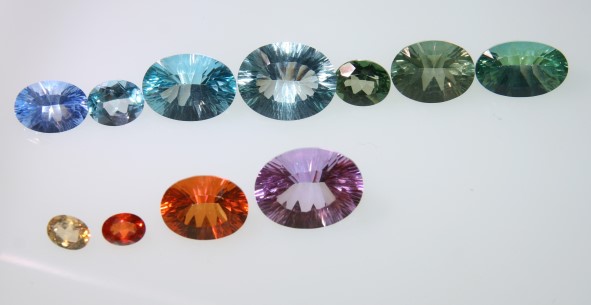
Vapor-coated quartz and topaze are becoming increasingly widespread in the jewelry sector
Foto: K. Sieber, www.makrogalerie.de
They have creativ sounding fantasy names such as "Angel Aura", "Aqua Aura" or "Tanzan Aura Quartz": gemstones with metallic coatings are spreading more and more in the form of cut jewelry and as treated raw crystals.
The process by which the crystals are coated is called "plasma sputtering" and works like a firing chamber in which a 2000°C hot plasma is generated. In this process, a metal vaporizes from an electrode that acts as a cathode. In the plasma, the metal is broken down into its atomic components and then deposited on all objects that are in the vicinity as an anode.
Originally, the process was developed to give any material new electrical and optical properties. However, as early as the 1970s it was discovered that the method was appropriate to create artificial color varieties of quartz and topaz for the jewellery market. As a result, some previously unknown color varieties came on the market (e.g. "Mystic Fire Topaz") beside many already known varieties like Citrine, Amethyst, Gold Topaz etc.

A thin layer of gold (Au) produces light blue tones on rock crystals (trade name "Aqua Aura"), a mixture of gold with platinum produces purple and silvery iridescent shades (trade name "Angel Aura"), indium provides dark blue, tanzanite-like colours ("Tanzan Aura Quartz") and bismuth gives a yellow, citrine-like appearance. Rock crystals coated with lead show green colors, chromium produces red tones and titanium dioxide a shimmer in rainbow colors (trade name "Rainbow Quartz"). In the meantime, the complete color spectrum of the rainbow is covered.
In the case of topaz, titanium (Ti) produces red colour varieties (trade name "Mystic Fire Topaz") and a mixture of iron and titanium (Fe + Ti) produces golden yellow colours ("Imperial Gold Topaz").
The metal layer has a thickness of only a few atomic layers and is not very resistant to scratches and exfoliation. The color-bearing layer wears off relatively quickly through everyday use in jewellery.
The first solution to avoid this defect is to apply the coating only to the bottom of a cut stone. This way the delicate surface is protected by the setting, while the color shines from the bottom through the intire stone.
The second method consists of protecting coated stones with a thin layer of synthetic diamond. This makes the surface more resistant to mechanical stress. For reasons of cost, both methods are used exclusively for cut (faceted) stones.
Advances in coating technology in recent years have led to a significantly improved appearance and a steadily growing number of gemstones suitable for this treatment. In addition to quartz, coatings are known on diamond, sapphire, topaz, emerald, opal, apatite, spinel, tanzanite and topaz.
A new trend is comming up by coating gemstones and artificial products with thin diamond-like layers (DLC - Diamond Like Carbon) or with synthetic diamond (CVD - Chemical Vapor Deposition) and thus change their optical and physical properties. Synthetic rubies, sapphires, emeralds and alexandrites with an artificial diamond coating are offered under trade names with the term "diamond" in the name, which is misleading according to the CIBJO. Unfortunately, misleading information in the promotion of the goods is used to disguise the fact, that they are synthetic stones. The artificial product zirconia (CZ), which is widely used as a diamond imitation, is coated with a thin diamond layer in the colors "emerald green", "ruby red" and "sapphire blue" and marketed under trade names such as Diamantine® or Diamondlite®.
Vaporized raw minerals are relatively easy to recognize by their characteristic surface iridescence. However, caution is needed with jewellery, as the coating can often only be detected by a careful microscopic examination.
Further literature:
Bruder, B. (2012): Enhanced Stones, 3rd ed., Neue Erde Verlag.
HENN, U. (2003): Precious stones with vapour-deposited, wafer-thin metal layers, currently Gemmol. Ges., 52, 1, 41-44.
RÖSSLER, L. (2007): Topase treated by vapor deposition, Gemmo News, Ö.Gem.G., 20, 10-11.




